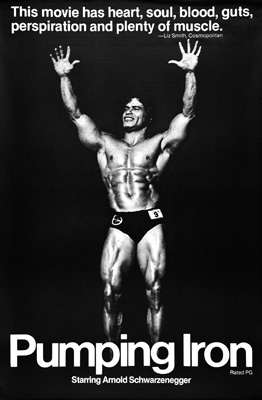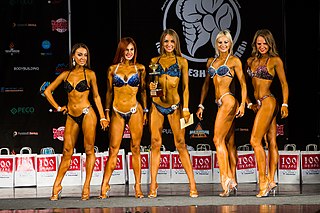
Bodybuilding is the practice of progressive resistance exercise to build, control, and develop one's muscles via hypertrophy. An individual who engages in this activity is referred to as a bodybuilder. It is primarily undertaken for aesthetic purposes over functional ones, distinguishing it from similar activities such as powerlifting, which focuses solely on increasing the physical load one can exert.

Pumping Iron is a 1977 American docudrama about the world of professional bodybuilding, with a focus on the 1975 IFBB Mr. Universe and 1975 Mr. Olympia competitions. Directed by George Butler and Robert Fiore and edited by Geof Bartz and Larry Silk, it is inspired by the 1974 book of the same name by photographer Butler and writer Charles Gaines and nominally centers on the competition between Arnold Schwarzenegger and one of his primary competitors for the title of Mr. Olympia, Lou Ferrigno. The film also features segments on bodybuilders Franco Columbu and Mike Katz, in addition to appearances by Ken Waller, Ed Corney, Serge Nubret, and other famous bodybuilders of the era.

Mr. Olympia is the title awarded to the winner of the professional men's bodybuilding contest in the open division at Olympia Fitness & Performance Weekend—an international bodybuilding competition that is held annually and is sanctioned by the IFBB Professional League. Joe Weider created the contest to enable the amateur Mr. Universe winners to continue competing and to earn money. The first Mr. Olympia was held on September 18, 1965, at the Brooklyn Academy of Music, New York City, with Larry Scott winning his first of two straight titles. The equivalent female title is Ms. Olympia.

Beverley "Bev" Francis is an Australian gym owner and retired professional bodybuilder, powerlifter, and national shot put champion.
Rachel Livia Elizondo McLish is an American female bodybuilding champion, actress, and author.
Female bodybuilding is the female component of competitive bodybuilding. It began in the late 1970s, when women began to take part in bodybuilding competitions.
Mary Roberts was one of the top professional female bodybuilders of the 1980s. She possessed a classic short (5-3), thick physique featuring an overwhelming upper body even as a lightweight. Roberts big arms, deltoids and chest with her mature looks and flashing, almost challenging dark eyes projected a very powerful, confident aura onstage.

The IFBB Professional League Ms. Olympia is professional bodybuilding's most prestigious competition and the title of the winner of the competition in female bodybuilding. It was first held in 1980. It was held as part of the Joe Weider's Olympia Fitness & Performance Weekend from 2000 to 2014 and since 2020.
Carla Dunlap-Kaan is a professional American female bodybuilding champion.

Serge Nubret was a French professional bodybuilder, actor and self-published author. He won numerous bodybuilding competitions, including 1976 NABBA Mr. Universe (1976). Nubret was nicknamed "The Black Panther."

Fitness and figure competition is a class of physique-exhibition events mainly for women but also men. While bearing a close resemblance to bodybuilding, its emphasis is on muscle definition, not size. The class was introduced when bodybuilding's popularity began to decline.
In bodybuilding and physique, a posedown is a free for all posing round in a bodybuilding or physique competition where the participants strike various poses, highlighting specific muscles and their overall physique. Posedowns are usually the final part of the competition and can often decide a close competition. Some competitors like to keep pre-set routine for the posedown in order to keep the flow going and show off their muscles. There are strategies competitors adopt during posedowns to best dominate or intimidate opponents, such as the forced perspective of posing as massive as possible and covering up other opponents on stage or forcing opponents into another pose, which can throw off their pre-set posing routine. For this reason, some competitors like to go through a spontaneous routine and keep the competition off-guard.
Kay Baxter was a pioneer female bodybuilder.
Kenny Waller is an American former bodybuilder featured in the 1977 movie Pumping Iron, which starred Arnold Schwarzenegger. Waller also won the 1975 International Federation of Bodybuilders (IFBB) Mr. Universe contest in Pretoria, South Africa. He was known for his curly red hair, freckles and his graceful, confident posing style.
Dona Oliveira was a professional female bodybuilder from the United States. She competed from the mid-1980s through the early 1990s.
Theresa Jean Bell, better known as Pillow, also known as The She-Beast, was a United States bodybuilder in the early 1980s. While competing in bodybuilding, she was also an exotic dancer in Alaska. She was crowned Miss Exotic World 1995. "Pillow" is her legal name.
The 1991 Ms. Olympia contest was an IFBB professional bodybuilding competition was held on October 12 and 13, 1991 at the Shrine Auditorium in Los Angeles, California. It was the 12th Ms. Olympia competition held.
Bodybuilding in the United States traces its early history to the 1860s when it was based on the east coast. By the 1940s, it had arrived in Hawaii. In the same period, the country was involved with the early internationalization of the sport. The sport had a golden age during the 1960s and 1970s when much of the activity was taking place on the west coast. Bodybuilding for women began to take off during the 1970s. A number of changes took place in the 1980s.
Bodybuilding in Australia traces its early history to the 1940s. In 1947 the first large scale national bodybuilding contest was held, and since then bodybuilding has continued to grow within Australia. It has diversified from originally being largely male-dominated to having equal, or in some instances more, women competitors. Australia has both produced high performing bodybuilders, such as Lee Priest, and also hosted some historically significant events in the field, such as the IFBB Mr Olympia in 1980 where Arnold Schwarzenegger was the winner.
Chinedu Andrew Obiekea born 1985, better known as Andrew Jacked is a Nigerian IFBB Pro League professional bodybuilder, trainer and fitness influencer, residing in Dubai, UAE. His latest victory was at the 2023 Texas Pro in Arlington, Texas. Obiekea first rose to prominence training with powerlifter Larry Williams before becoming one of the most notable bodybuilders in the 2020s.






